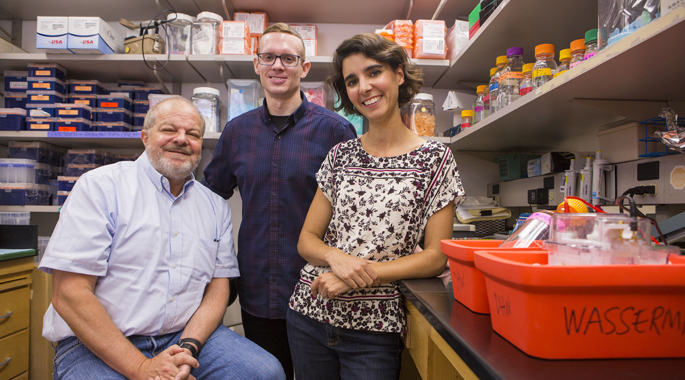High circulating glucose, the hallmark of diabetes, is linked to the disease’s most serious complications including heart disease, kidney failure, blindness and amputation. Diabetes is the sixth leading cause of death and costs the nation an estimated $322 billion a year.
Restoring the action of insulin has been the traditional treatment route. Insulin, a hormone produced by beta cells in the pancreatic islets, lowers blood glucose by stimulating uptake of glucose by muscle and other tissues and by suppressing glucose production by the liver.
Another possible approach is to block the actions of another pancreatic hormone, glucagon, which normally stimulates the liver to make more glucose when blood glucose levels fall.
While blocking glucagon action lowers blood glucose levels, it also unexpectedly triggers proliferation of glucagon-producing alpha cells in the pancreatic islets. It is not known whether this proliferation has the potential to become cancerous, but clearly more needs to be learned before this approach is used to treat diabetes.
Now researchers at Vanderbilt University Medical Center have discovered some of the factors that lead to alpha-cell proliferation when glucagon signaling is interrupted. Their findings, reported this week in the journal Cell Metabolism, could lead to new ways to lower blood glucose and improve diabetes treatment.

“This discovery was a real team effort,” said first author Danielle Dean, Ph.D., a post-doctoral research fellow in the lab of Alvin C. Powers, M.D., director of the Vanderbilt Diabetes Research and Training Center. “Vanderbilt’s collaborative environment, especially within the center, was a driving force.”
The researchers studied three models of interrupted glucagon signaling. Dean made some preliminary findings in mouse and human islet models. Coauthor Wenbiao Chen, Ph.D., a zebrafish expert, tested Dean’s findings in a zebrafish model of interrupted glucagon signaling he created.
The researchers discovered a previously unrecognized connection between alpha cells and the liver. They found that high levels of amino acids – notably L-glutamine – that are produced by the liver when glucagon is blocked turn on genes in the pancreas to stimulate alpha-cell proliferation.
Further study is needed to determine what impact, if any, rising L-glutamine levels have on other tissues and on cancerous growth.
Meanwhile other researchers are studying how to convert glucagon-producing alpha cells into insulin-producing beta cells in order to restore insulin action lost in diabetes. If they succeed, promoting alpha-cell proliferation by blocking glucagon signaling could provide a new way to boost the number of insulin-producing cells in diabetes patients.
“Dr. Dean’s research has discovered a new axis between the liver and pancreas,” said Powers, the Joe C. Davis Professor of Biomedical Science in the Vanderbilt University School of Medicine and current president of the Medicine and Science of the American Diabetes Association.
“This opens up a new area for investigation about how amino acids influence islet cell growth and function,” he said.
Chen is associate professor of Molecular Physiology and Biophysics. Other Vanderbilt faculty members who contributed to the study were Roland Stein, Ph.D., Mark Collie Professor of Diabetes Research, Chunhua Dai, M.D., research associate professor of Medicine, and Kasey Vickers, Ph.D., assistant professor of medicine and Molecular Physiology and Biophysics.
The research was supported by the Juvenile Diabetes Research Foundation, U.S. Department of Veterans Affairs, the Vanderbilt Diabetes Research and Training Center and its Islet Procurement and Analysis Core and National Institutes of Health grants including DK007563 and DK106755.















